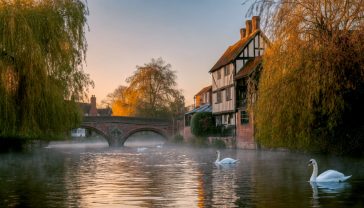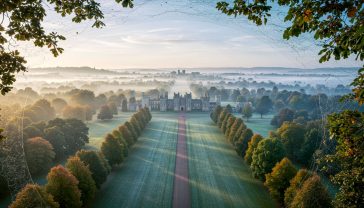Discovering the Timeless Charm of the Cotswolds: A Journey Through History
Explore the timeless charm of the Cotswolds. Our ultimate guide covers its history, famous villages, the wool trade, and why it’s a true English treasure.

This post may contain affiliate links. If you make a purchase through these links, we may earn a commission at no additional cost to you.
Picture this: a gentle, rolling hill, bathed in the soft glow of a late afternoon sun. A dry-stone wall, built from honey-coloured stone, zig-zags its way across a impossibly green field dotted with fluffy sheep. In the valley below sits a village, not of brick and concrete, but of that same warm, golden stone. It feels like you’ve stepped straight into a history book, or maybe just the most beautiful biscuit tin lid you’ve ever seen.
This is the Cotswolds. It’s a place that feels deeply, quintessentially English. But it’s not a film set, and it wasn’t built for tourists. This landscape is a living, breathing storybook, written over millions of years by oceans, shaped by sheep, and built by the incredible wealth they generated.
So, grab a cuppa. We’re going on a journey through time to uncover how this magical corner of England came to be. We’ll dig into the ground to find its secrets, meet the Roman soldiers who marched its roads, and follow the money from the wool trade that transformed it into the treasure we see today.
What is the Cotswolds? The Heart of England Explained
First things first, what and where is the Cotswolds? It’s not one town or a single county. It’s a range of rolling hills, a protected landscape that stretches across six counties, mainly Gloucestershire and Oxfordshire. In 1966, it was officially named an Area of Outstanding Natural Beauty (AONB), which is a bit like a National Park. It’s a special status that protects its unique character for everyone to enjoy.
The word ‘Cotswold’ itself tells a story. ‘Cot’ is an old word for a sheep pen, and ‘wold’ means gentle hills. So, quite literally, it means ‘sheep pens on the rolling hills’. And for centuries, that’s exactly what it was.
But the real secret to the Cotswolds’ charm, the thing that makes it look so different from the rest of the country, is something much, much older than sheep. It’s the stone right under your feet.
The Bones of the Hills: How Cotswold Stone Was Made
You can’t talk about the Cotswolds without talking about its famous honey-coloured stone. Every village, church, and country manor seems to glow with a warm, golden light. This isn’t a design choice; it’s the very DNA of the place.
So where did it come from? We need to rewind the clock about 170 million years to the Jurassic Period. Back then, Britain wasn’t a chilly island. It was covered by a warm, shallow tropical sea, a bit like the Bahamas today.
Over millions of years, the shells and skeletons of countless tiny sea creatures fell to the seabed. The immense pressure of the water above squashed these layers together, slowly forming a type of rock called oolitic limestone. When you look closely at a block of Cotswold stone, you can sometimes see the tiny, rounded grains (called ‘oolites’), which are the fossilised remains of that ancient sea life.
As the stone was quarried in different areas, it came out in slightly different shades. In the north, around towns like Chipping Campden and Broadway, the stone is a rich, deep honey colour. Travel south towards Bath, and it becomes a paler, creamier yellow. This is why each village has its own unique, yet harmonious, character. It was literally built from the ground it stands on.
From Ancient Britons to Roman Roads: The Early Story
Long before the pretty villages, ancient people recognised this was a good place to live. The high ground of the ‘wolds’ made for excellent defensive positions. Dotted across the landscape are the mysterious remains of Neolithic long barrows, which were communal burial mounds built over 5,000 years ago. Places like Belas Knap, near Winchcombe, give you a real sense of this ancient, ritualistic past. You can even walk inside its stone-lined chambers.
Then, around 2,000 years ago, the Romans arrived. They were expert engineers and administrators, and they quickly turned the Cotswolds into a key part of their new province, Britannia. They built one of their most important roads, the Fosse Way, straight through the heart of the region. It’s still there today as a modern road, the A429, connecting ancient Roman towns.
The capital of the Roman Cotswolds was Cirencester, which they called Corinium Dobunnorum. It grew to become the second-largest town in Roman Britain after London. It was a bustling centre with an amphitheatre, a forum, and grand townhouses decorated with stunning mosaic floors. Today, you can see many of these incredible finds in the town’s Corinium Museum.
The Golden Fleece: How Sheep Built the Cotswolds
After the Romans left, things went quiet for a few centuries. But during the Middle Ages, the Cotswolds found its true calling: sheep. This wasn’t just a bit of farming; it was the engine of the entire English economy.
The Rise of the ‘Cotswold Lion’
Medieval England’s wealth was built on wool. It was like the oil of its day, and English wool was the best in the world—thick, long, and soft. The sheep that produced this prized fleece, a sturdy breed with a shaggy coat, were grazed in their thousands on the grassy wolds. They became so famous and so valuable they were known as the ‘Cotswold Lions’.
Wealthy merchants, known as woolmen, bought up this fleece and sold it across Europe. They became fantastically rich, and they weren’t shy about showing it off. They began pouring their money back into the villages where they lived, creating the architectural masterpieces we now flock to see.
Wool Churches and Wealthy Merchants
The grandest statements of all were the magnificent ‘wool churches’. These huge, cathedral-like parish churches dominate the small towns and villages they serve. Places like St. James’ Church in Chipping Campden, St. Peter and St. Paul’s in Northleach, and the church in Cirencester are breathtaking. They were built with huge windows, towering arches, and fine carvings—all paid for with the profits from wool.
Inside these churches, you can still see the evidence. Look for the memorial brasses on the tombs of the wealthy wool merchants. They are often depicted with their feet resting on a sheep or a wool-sack, a clear symbol of where their fortune came from. They were proud of their trade and wanted everyone, and God, to know it.
A Landscape Shaped by Sheep
The wool trade didn’t just build churches; it shaped the entire landscape. To control the vast flocks of sheep, thousands of miles of dry-stone walls were built. These walls, which use no mortar, are a work of art in themselves. They snake across the hills, marking out fields that have been used for centuries.
The huge, open fields were perfect for grazing, and the network of ancient tracks and drovers’ roads, used to move the sheep to market, still criss-cross the countryside. When you walk in the Cotswolds today, you are literally following in the footsteps of medieval shepherds.
Rags to Riches… and Back Again: Decline and Rediscovery
All good things come to an end. By the Tudor period, the wool trade began to change. New types of cloth became popular, and the industry shifted to other parts of the country, like Yorkshire and East Anglia, where new mechanised mills were being built.
The Cotswolds, once the booming heart of England, slowly fell into a peaceful decline. The stone villages, no longer flush with cash, were left largely untouched. For hundreds of years, time seemed to pass them by. While other parts of Britain were transformed by the Industrial Revolution, with its canals, railways, and factories, the Cotswolds slumbered on.
This, ironically, was its saving grace. Because nothing much happened, the beautiful medieval buildings and the ancient landscape were perfectly preserved, like a fly in amber.
It wasn’t until the late 19th and early 20th centuries that people started to notice this forgotten corner of England again. And the people who noticed first were artists, thinkers, and writers who were fed up with the dirt and grime of modern industrial cities.
A Simple Beauty: The Arts and Crafts Movement Arrives
One of the most important figures to rediscover the Cotswolds was William Morris, a designer, writer, and one of the founders of the Arts and Crafts Movement.
Who Was William Morris?
Morris and his friends were horrified by the mass-produced, soulless goods being churned out by Victorian factories. They believed in the beauty of things that were made by hand, with skill, care, and natural materials. They wanted a return to a simpler, more honest way of life and making things.
In the 1870s, Morris took a lease on Kelmscott Manor, a beautiful old farmhouse on the edge of the Cotswolds. For him, it was a kind of paradise, a perfect example of timeless, honest English craftsmanship. He called it “heaven on earth.”
Crafting a New Utopia
Inspired by Morris, other artists and craftspeople began to see the Cotswolds as a kind of utopia. They were drawn by the unspoiled landscape, the beautiful stone buildings, and the long traditions of rural craftsmanship (like stonemasonry and blacksmithing) that had survived there.
One of the most famous examples was the architect and designer C.R. Ashbee. In 1902, he moved his entire Guild of Handicraft—lock, stock, and barrel—from the noisy East End of London to the peaceful market town of Chipping Campden. He brought 150 men, women, and children with him, setting up workshops to make beautiful furniture, metalwork, and jewellery.
These Arts and Crafts pioneers didn’t just move to the Cotswolds; they celebrated it. They repaired old buildings, learned from local craftsmen, and helped to cement the idea of the Cotswolds as a place of simple, timeless beauty. Their legacy is a huge part of why we value it so much today.
Preserving Paradise: The Cotswolds Today
The 20th century brought new challenges. The arrival of the motor car meant that suddenly, this quiet backwater was accessible to everyone. The very things that made it special—its peace, its beauty, its untouched nature—were now under threat.
An Area of Outstanding Natural Beauty
People realised that this precious landscape needed protecting. This led to its designation as an AONB in 1966. This status helps to conserve and enhance the natural beauty of the area. It means there are strict planning rules to ensure that new buildings blend in and that the traditional character of the villages isn’t lost. It’s a big reason why the Cotswolds still looks and feels so special.
Tourism, Traffic, and Tea Rooms
Today, the Cotswolds is one of Britain’s most popular visitor destinations. People come from all over the world to see the honey-coloured villages, walk the rolling hills, and enjoy a cream tea in a cosy cafe.
This popularity is a double-edged sword. It brings vital income to the area, keeping the pubs, shops, and hotels in business. But it also brings challenges. On a sunny bank holiday weekend, the narrow streets of villages like Bourton-on-the-Water or Bibury can become clogged with traffic and crowds.
Finding the balance between being a thriving tourist destination and a peaceful, living community is the great challenge for the modern Cotswolds.
Famous Faces and Rolling Hills
The timeless charm and relative privacy of the Cotswolds have also made it a magnet for the rich and famous. From rock stars to royalty, many have chosen to make their home here. The area around Chipping Norton, in particular, has become so well-known for its high-profile residents that it’s sometimes nicknamed the ‘Chipping Norton set’.
Your Journey Through Time: A Visitor’s Guide to the Historic Cotswolds
Exploring the Cotswolds is like having your own personal time machine. Here’s how you can step back into its history.
Must-See Historic Villages
- Bibury: William Morris himself called it “the most beautiful village in England.” It’s famous for Arlington Row, a stunning line of 14th-century weavers’ cottages. This is the Cotswolds you see on postcards.
- Stow-on-the-Wold: A classic market town sitting on a high hill. Its huge market square is a reminder of the massive sheep fairs held here. Look for the ancient yew trees framing the door of St. Edward’s Church—it looks like something from The Lord of the Rings.
- Chipping Campden: Perhaps the most perfect of the ‘wool towns’. Its magnificent church and beautiful, curving high street are a testament to the wealth of the medieval wool trade. It’s also the heart of the Arts and Crafts movement.
- Broadway: Known as the ‘Jewel of the Cotswolds’. Its wide, tree-lined high street is packed with beautiful buildings. Climb the nearby Broadway Tower, a quirky folly, for the best views across the entire region.
- Castle Combe: Often voted the ‘prettiest village in England’. Nestled in a wooded valley, it feels completely cut off from the modern world. It has no streetlights or TV aerials, which is why it’s so popular with film crews.
Walking Through History
The best way to experience the real history of the Cotswolds is on foot. The Cotswold Way is a 102-mile National Trail that runs along the western edge of the hills, from Chipping Campden down to the city of Bath. You don’t have to do it all! A short circular walk from a village will take you past ancient burial mounds, over rolling hills criss-crossed with dry-stone walls, and through fields where sheep still graze. It’s the closest you can get to seeing the landscape as it was hundreds of years ago.
Top Tips for Your Trip
- Visit off-season: The Cotswolds is beautiful in autumn and spring, and much quieter than in the summer holidays.
- Wear sensible shoes: Many of the village streets are cobbled and uneven. If you’re walking, you’ll need proper walking boots.
- Book ahead: If you want to stay overnight or eat in a popular pub, it’s a good idea to book in advance, especially at weekends.
- Explore the smaller villages: The famous spots can get very busy. Don’t be afraid to take a detour and explore the quieter, lesser-known hamlets. That’s often where you find the real magic.
Conclusion: The Enduring Charm of the Cotswolds
The Cotswolds is more than just a pretty place. It’s a landscape where history is written in stone. Every golden wall, towering church, and rolling hill tells a part of the story. It’s a story of ancient seas, Roman legionaries, and medieval merchants who built a world on the back of a sheep.
It was preserved by neglect and rediscovered by artists who saw the beauty in its simplicity. Today, its charm endures, drawing us in with a promise of a quieter, more beautiful version of England. It’s a reminder that the most timeless things are often made slowly, from the earth itself, and are worth preserving for the future.
Further Reading
To continue your exploration of the Cotswolds, here are some highly respected resources:
- Cotswolds National Landscape: The official website for the Area of Outstanding Natural Beauty, with information on conservation, walking routes, and visitor information. https://www.cotswolds-nl.org.uk/
- National Trust: The Trust cares for many key historic properties and landscapes in the Cotswolds, including Hidcote Gardens and Chedworth Roman Villa. https://www.nationaltrust.org.uk/cotswolds
- English Heritage: Manages important historical sites in the region, such as Hailes Abbey. https://www.english-heritage.org.uk/
- The Cotswold Way National Trail: The official guide to the long-distance walking path. https://www.nationaltrail.co.uk/en_GB/trails/cotswold-way/






